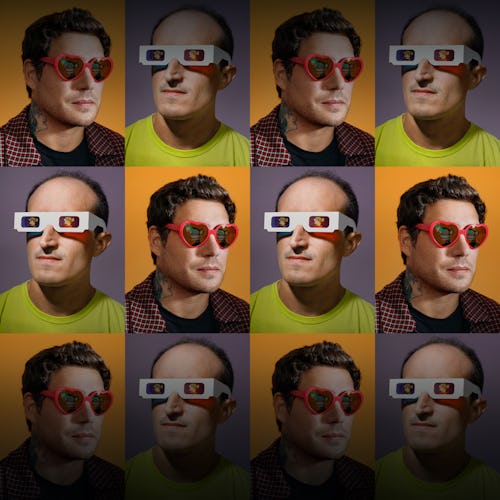
The evening of February 4, business partners Greg Solano, 33, and Wylie Aronow, 35, were at their respective homes with their significant others when they got some alarming news.
They had just learned that BuzzFeed News was going to publish a story revealing their identities — heretofore carefully hidden, or so they thought — to the wider world.
“We got 20 minutes warning,” Solano recalls, speaking earlier this month at a hotel in downtown Manhattan.
As Solano and Aronow do when making big, and even small, decisions about their business, they immediately jumped on a call — to freak out together and plan their next moves. “There were very real security concerns, to be frank,” says Aronow, sitting next to Solano on a bench in the hotel’s courtyard restaurant. Bad actors could try to hack their accounts. People might show up at their homes — or worse. “We didn’t know what to expect,” they both say now.
They began taking down personal information from the internet — Aronow recalls deactivating his Instagram, fearing it might contain clues as to the location of his home — and warning their families about what was coming, lest they be targets, too.

While Aronow’s immediate family understood exactly why the impending article would cause such concern, Solano had to explain the specifics to his father: He and Aronow were the creators of the Bored Ape Yacht Club, the internet’s hottest NFT project. Yuga Labs — the company through which they launched the Bored Ape Yacht Club in April 2021 — is currently valued at $4 billion.
The Bored Apes are a collection of 10,000 unique digital head-and-shoulders drawings of simians, each with a unique combination of traits, ranging from the common (“bored” mouth) to the ultra-rare (“solid gold” fur). Last October, a rare Ape sold at Sotheby’s for an eye-watering $3.4 million. That same month, Guy Oseary, a veteran talent manager who represents Madonna and U2, came on as a BAYC business partner.
Today, the Apes are everywhere in popular culture, from T-shirts sold at Old Navy to a VMA-nominated music video by Snoop Dogg and Eminem. Celebrities like Steph Curry, Justin Bieber, Gwyneth Paltrow, Post Malone, and Seth Green own them. Other high-profile holders include Jimmy Fallon and Paris Hilton, who in January engaged in an infamously cringe exchange about their Apes on The Tonight Show. (Solano and Aronow, who say they weren’t aware of the Fallon segment in advance, found it “very surreal.”)

Though the crypto and NFT markets crashed this year, the Apes are still considered a “blue chip” investment in the space. The current floor price of an Ape stands at roughly $140,000, down from a high of about $434,000 in April. With every secondary sale of a Bored Ape NFT, Yuga Labs gets a 2.5 percent royalty.
Solano’s father was aware that his son was working on a project in the NFT and crypto space but didn’t know the details until he got the call from his son that February evening. “I hadn’t told my dad because he would tell everybody,” explains Solano, who is of Cuban descent. “He’d tell the woman at la carreta, the coffee shop: ‘My son is the one who’s behind this! Who else can know, who else can know?’”
This would have been a problem because, up until the BuzzFeed article dropped, most people only knew the duo by the handles they use online — Solano is Gargamel, after the villainous wizard from The Smurfs, and Aronow is Gordon Goner, a punk-inspired name — and their corresponding Ape avatars.
The same went for BAYC’s other two co-founders, the guys on the technical end of things: Zeshan Ali, 32, who went by No Sass, since shortened to Sass (“Here for the Apes. Not for the sass,” his bio on the BAYC site reads), and Kerem Atalay, 31, AKA Emperor Tomato Ketchup (a name taken from an album by the Anglo-French indie pop band Stereolab).
And all four of them wanted to keep it that way. In their minds, Solano and Aronow were being doxxed. (Ali and Atalay’s identities were not revealed in the piece.) Buzzfeed News senior tech reporter Katie Notopoulos, who wrote the article, disagrees with that assessment. “I would characterize it as journalism,” Notopoulos tells Input. “So would many other reasonable people.” As she explained on the Untangled podcast in June, “It seemed against all norms of society that we don’t know the people that are running” a multibillion dollar company.
While charting their plan of action on the phone, Solano and Aronow decided it was best to “doxx themselves” first by tweeting out their photos. “[Aronow] found a good picture of himself so fast,” Solano marvels. They didn’t preempt the BuzzFeed piece, but both revealed their real faces to the internet within an hour of the story’s publication.
Four days later, Ali and Atalay followed suit, posting their first names and photos of themselves on Twitter. “We wanted to have a little bit more control over the narrative,” Atalay says, “and make it more of a celebratory thing than it was for Greg and Wylie.”
Now, all these months later, Solano and Aronow are trying to wrest back control of their own narrative. Thus, this meeting, with their publicist in tow, to finally tell their story in full for the first time — and to publicly address a major controversy that has been bedeviling them for the better part of a year.
‘F*cking evil’
During our time together, Solano and Aronow exude a fraternal but guarded vibe. “We’re the most superstitious people in the world,” says Solano, who wore a chartreuse tee to the interview because Aronow thought he needed “yellow energy.”
Aronow sports an amber bracelet that he feels is “positive” and barely eats his cheeseburger. At one point, Solano teases his friend good-naturedly about his dietary habits. “Wylie only eats, like, cheeseburgers and chicken tenders,” he says. “We joke that he’s got ‘baby mouth.’”
I later learn that this is the result of a debilitating illness that kept Aronow bedridden for the better part of a decade, starting in his early 20s. He’s able to manage the condition now, but the situation remains precarious — even salad is a threat, something that can cause his ailment (he won’t say what it is) to flare up again.
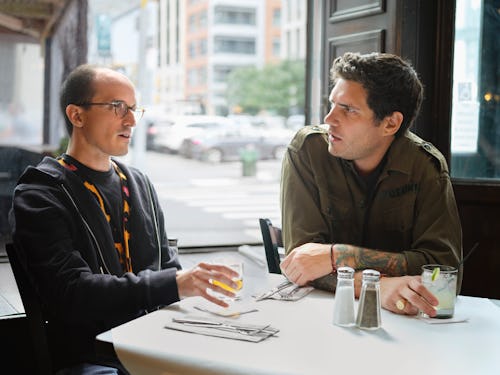
So can stress. And being the now public faces of Yuga seems like it could be nerve-wracking. The company is growing: In March, it purchased two of the other most popular NFT collections, CryptoPunks and Meebits, from creator Larva Labs. Shortly thereafter, Yuga introduced what is essentially its own cryptocurrency, ApeCoin.
And days from when we speak, Yuga will host a large-scale demo of Otherside, the immersive game it’s been developing with the U.K.-based studio Improbable. Only, it’s not just a game — it’s the beginning of a Web3 metaverse open to the masses outside the Bored Ape community. Yuga will be in direct competition with huge companies like Meta.
Even more stressful, however, is the lawsuit. In June, Yuga sued the conceptual artist Ryder Ripps — known for collaborating with artists like Kanye West and brands like Gucci — for trademark infringement, among other complaints, after he created an NFT collection identical to the Bored Apes in May. The project made an estimated $1.8 million in profit, according to Artnet. (Major NFT marketplace OpenSea removed the collection.)
But Ripps’ copycat project, dubbed RR/BAYC, is just part of the problem. (Ripps tells Input he collaborated with three others on RR/BAYC, including NFT marketplace creator Jeremy Cahen, who was also sued.) Since the end of last year, Ripps has been very publicly voicing allegations that BAYC is rife with racist and neo-Nazi symbolism. The BAYC founders deny the claims, alleging they’re all part of a scheme to drum up interest in Ripps’ knockoff Apes.
“It’s extremely apparent to anybody who knows our history how absurd this is,” says Solano. “That said, the persistence, the maliciousness of the troll — frankly, how fucking evil the whole thing is — it’s hard.”
A grave look passes over Aronow’s face as he describes the barrage of online hate they get as a result of the allegations. “It’s all day, every day,” he says.
Odd couple
“Just for context, we really are kind of an odd couple,” Aronow says, referring to his friendship with Solano. This much is immediately obvious. The first thing you notice is the business partners’ dramatic height difference — Aronow, at 6 feet, 2 inches, towers above Solano.
Aronow has a head of thick dark hair and is covered in tattoos. (He is embarrassed of the lifelike portrait of author Charles Bukowski on his right arm, which he got during his teenage years.) His voice is deep and booming. He is the human embodiment of the NFT enthusiasts’ rallying cry “LFG” (“Let’s Fucking Go”). Solano, who is balding, goateed, and soft-spoken, calls Aronow the perfect motivational “gym buddy.”
“We’ll fight on every single idea, whether it’s as simple as a tweet or a whole NFT project,” says Aronow. In fact, their friendship began with a fight. Around a decade ago, the pair — both home during a break from college — met for the first time in a Miami dive bar, where they proceeded to debate the merits of David Foster Wallace’s Infinite Jest, a book Solano hadn’t even read but hated reflexively because his creative writing classmates fawned over it. They stayed in touch long-distance, arguing about books, movies, and ideas, and playing World of Warcraft together online.
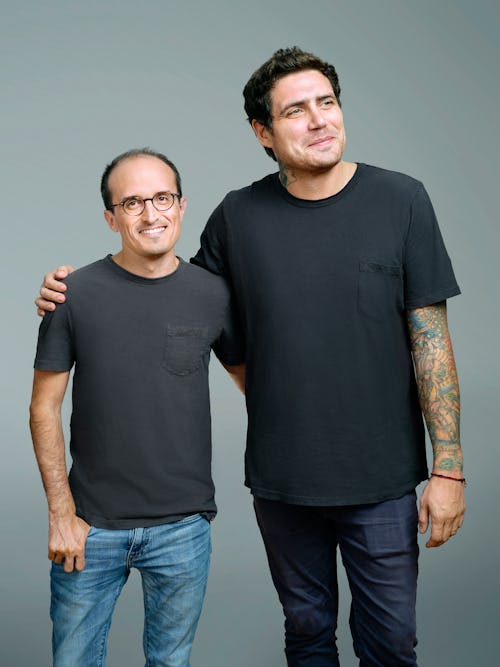
Years later, in 2017, the two started talking crypto. Like everybody else, they tried to make some money during the bull run. (“We rode the wave all the way up,” says Aronow, “and all the way down.”) But what interested them most were the possibilities presented by the Ethereum blockchain, upon which people were building decentralized apps, including gamified collectibles like CryptoKitties, unique cartoon cats you could buy, trade, and breed to create even more Kitties.
Despite his interest in digital collectibles, Solano didn’t buy his first nonfungible token until early 2021. Shortly thereafter, in February, Solano texted Aronow about starting an NFT project of their own. “We instantaneously started ideating,” Aronow says. One of those ideas was a communal digital canvas, which Aronow shared with his longtime friend Nicole Muniz, now CEO of Yuga. She sagely predicted that someone would draw a dick on it.
The guys ran with that. “I was like, ‘Where would you draw a penis?’” Aronow says. Answer: on a dive bar’s bathroom wall. “What kind of people would go there?” The kind of people he knew from crypto Twitter, who’d gotten rich from digital currencies but still just wanted to screw around online playing MMORPGs instead of living the expected lavish lives of multimillionaires.
Aronow sent Solano “this whole essay” mapping out the idea, in which the name “Bored Ape Yacht Club” appeared. “Being the great editor he is, [Solano] goes, ‘That’s it. That’s the idea,’” Aronow recalls. The concept evolved into the millionaires being actual apes — in crypto, the term “aping in” means compulsively investing in a new project without doing much research — living in the year 2031. Aronow says he and Solano started an LLC “on, like, Day Two.” (It was associated with Solano’s then address — information BuzzFeed used to discern his identity.)
“I would love to talk to other people who suddenly created something that became so wildly popular very fast. It’s just incredibly surreal.”
They weren’t artists — at the time, Solano was working in publishing, and Aronow didn’t have a job — so they hired a team to execute their idea. Muniz, the founder of a brand consulting agency, introduced them to a visual artist known as Seneca, who worked on the initial BAYC concept art based on directions like “bedraggled punk rock” and “a dive bar in the Everglades.” Four other artists helped design the initial 10,000 Apes.
In a Rolling Stone profile earlier this year, Seneca called her compensation for the project “not ideal.” The duo say they compensated her roughly two weeks’ worth of Solano’s then five-figure salary for four to five days of work and, at the end of last year, paid out $1 million each to Seneca and the other four artists. (Seneca did not respond to Input’s request for comment.)
Meanwhile, Solano got in touch with his friends Ali and Atalay, who’d met studying computer science at the University of Maryland. (Solano had gotten to know Atalay first, while they were both at University of Virginia — Solano for his MFA, Atalay for undergrad.) Ali grew up on the West Coast to immigrant parents from Guatemala and Pakistan who met taking English language classes. Atalay’s parents are also immigrants, from Turkey; he says he had a “normal, suburban upbringing,” mostly in the Washington, D.C., area.
Solano, not being a programmer, asked if they knew Javascript, which is not the relevant coding language for blockchains. The technical duo quickly learned the right language, Solidity. “That was kind of the easiest part,” Atalay says, because the nonfungible ERC-721 token standard used to code NFTs had long been public and therefore easy enough to use as a boilerplate.
The complexity came with managing the project’s multiple components — the website, the smart contracts, the token-gated community spaces — and stringing them together. Doing that with only two people, especially ones just learning blockchain coding, was “a big lift,” Ali says.

But they made it work. The presale and mint launched on April 23, 2021. And on the evening of April 30 — Hitler’s death date, as Ryder Ripps and other BAYC conspiracy theorists will point out — the foursome revealed the Apes, which went for $200 a pop. Then they went to bed.
Around 3 a.m. on May 1, Ali got a call from Atalay. Ali figured something had gone “terribly wrong,” he says, but instead, he and Atalay spent the early morning hours watching the collection sell out in real time. (Turns out that word of the BAYC had spread throughout the zealous NFT community.) It was the moment they knew they’d created something big.
That all happened almost exactly 15 months ago. Shortly thereafter, all four co-founders started working at Yuga Labs full time. Yuga added new NFTs to the Ape family, giving them dogs (via the Bored Ape Kennel Club) in June 2021 and Mutant Apes that August; the latter collection sold out to the tune of $96 million in the hour after launch. Steph Curry, one of the first celebrity holders, bought his Ape for roughly $180,000 that same month.
Muniz came onboard as a partner in September 2021 (the month before Oseary did) and became CEO in January. In March 2022, Yuga Labs raised $450 million in a funding round led by Andreessen Horowitz. Today, the company has about 70 employees. “I would love to talk to other people who suddenly created something that became so wildly popular very fast,” says Aronow. “It’s just incredibly surreal.”
The four founders insist they’re not living glamorous lifestyles. All of them bought homes, in locations across the U.S. that they decline to disclose (except for Solano, who lives in Miami). But Solano and Aronow say they mostly stay in theirs, working at least 10-hour days in their home offices — Solano’s unadorned, Aronow’s covered in BAYC paraphernalia and children’s wallpaper, which he says came with the house.
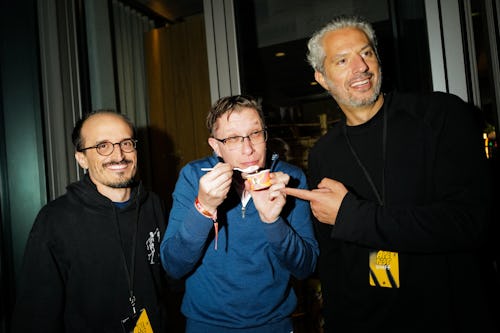
But they do get to meet celebrities, like Snoop Dogg and Colin Kaepernick. “Sometimes Guy will introduce us to somebody on a Zoom call,” Aronow says. Oseary will hold up his phone to the screen “and he’ll be FaceTiming with someone who I totally idolized.” Aronow’s favorite celebrity encounter was with primatologist Jane Goodall (Yuga Labs contributed one percent of the total ApeCoin supply to her foundation). Solano says he liked meeting the digital artist Beeple.
What’s changed most for Solano, perhaps, is that he’s now nonchalant about taking business calls with famous people. In the past, he says, he was so introverted that “I wouldn’t want to call to order Pizza Hut.”
Weird characters
Solano and Aronow both grew up in Miami, which they lament has become less cool thanks to the very industry they’re a part of. Their Miami is not the concrete jungle of crypto bros living in high rises downtown. Aronow’s Miami in particular is “lush and green and beautiful and full of really weird characters,” he says.
As a kid, he met many of those characters — powerful “1980s Miami Vice days dudes” who were his father’s old friends. They’d take him out to lunch to tell him stories about his dad, Don Aronow, who was murdered in 1987, when Wylie was just a baby.
The Brooklyn-born son of Jewish immigrants, Don Aronow made his fortune in the 1950s in New Jersey construction, later becoming a leader in the powerboat industry and getting famous in the process. He was there for the “advent of that industry,” says Wylie, selling boats to, and mingling with, “movie stars, kings, and queens.”
Future President George Bush Sr. was a friend who owned Don’s powerboats. U.S. border security agents used his boats — as did the drug smugglers they were chasing. John Travolta played Don in a 2018 movie, Speed Kills, which Wylie describes as “terrible” and RogerEbert.com gave half a star.
In 1987, Don was shot dead in his car in North Beach. He was 59. About a decade later, two men — a former powerboat industry competitor and the hitman he allegedly hired — pleaded “no contest” to his murder. But still, conspiracy theories swirled around the businessman’s death, ones involving mob connections and a jealous partner of an alleged mistress. According to online speculation, Don was a CIA agent.


Whatever the true account of Don’s life and demise — Wylie says the stories he heard from his father’s friends often conflicted with those of his mother, former Wilhelmina agency model Lillian Aronow — his death deeply affected Wylie’s childhood. He grew up in Coconut Grove with his mom, stepdad, and a brother, who is eight years older and a “barroom hero” in the Miami punk scene.
Aronow says he doesn’t want to offend his parents, but describes his home environment as “shitty.” He spent a lot of his childhood escaping into video games like Final Fantasy. By around age 12, he was regularly running away from home and, like his older brother before him, attending local punk rock shows. There, Aronow found a kind of “second family” of similarly troubled people.
By 15, Aronow was an alcoholic and crack addict. He’d leave home for months at a time, sleeping in construction sites and mangrove forests with other young runaways. He’d already been to the same “court-mandated treatment” facility twice, he says. One facility director “literally said that I was the worst case of alcoholism he had ever seen in an adolescent,” he adds.
He was sent to a second, “really messed-up” facility. “Like the kind of thing Paris Hilton went to, where they kidnap you in the night and take you out into the desert,” he says. The people who ran the Utah center wouldn’t let him read anything, he says, except for the Bible or the “Big Book,” which is essentially the bible for Alcoholics Anonymous. Aronow chose the latter — he says he read it about 50 times while in Utah — and it changed his life.
“The moment I got back to Miami, I became Captain A.A., trying to help other alcoholics see the same message I felt in the desert,” he says. Still just 15, he chain-smoked and drank black coffee with recovering alcoholics decades his senior. (These days, Aronow will have the occasional drink, but no drugs.)
“I really want to give this everything because in the back of my head, I’m like, ‘Maybe I’m going to get sick again.’”
Aronow attended college and had hopes of attending a top MFA program, like the one at Syracuse, where his hero, the author George Saunders, teaches. Those dreams were dashed when Aronow got very sick in his early 20s and had to drop out.
Again, Aronow won’t name his ailment — given his superstitious nature, he doesn’t want to give it “that kind of energy” — but it kept him in bed for much of a “really dark decade.” Due to his illness, his family supported him financially. He traveled the country to find doctors who could help him (mostly to no avail), learned meditation, and hung out in online communities, “living vicariously” through Twitch streamers and YouTubers. He traded crypto but never held a true 9-to-5. He somehow managed to meet his current girlfriend.
Finally, in his early 30s, he found the right specialists, the right medication, and the right diet. He got better. And then, around that same time, the rest of the world fell ill: The COVID pandemic took hold. With everyone stuck at home, people sought online outlets for community involvement, just like Aronow had for the past decade. NFTs as art and collectibles came on the scene in a big way.
Then, in February 2021, Solano texted Aronow: “Hey, you want to make an NFT?”
“It was like, ‘I want to do anything,’” Aronow says. “I really want to give this everything because in the back of my head, I’m like, Maybe I’m going to get sick again.”
Normal people
By his own admission, Solano’s backstory is nowhere near as dramatic as Aronow’s. His parents are both Cuban immigrants who arrived in the U.S. very young — his mother as a baby, his father just before he was old enough to be inducted into the Young Pioneers, a communist youth group. (Solano only went to Cuba for the first time about seven years ago.)
While Solano’s mother spent her whole life in Miami, his father moved there in his 20s after a stint with the U.S. Army Special Forces, AKA the Green Berets. His parents divorced when Solano was about 11, and he and his older sister lived with his mom, who worked at a television network he declines to name.
Solano had wanted to be a writer since he was 11. After graduating from New York University, he moved south to get his MFA at the University of Virginia, which ended up being “the best years of my life,” he says. He got to spend all his time writing, he made fast friends, and he met his future wife, now a professional landscape designer, who first approached him because she liked his poetry.
“You view [the founders] online as this larger-than-life persona. Then you meet them in person, and it’s like, OK, that literally could have been me.”
After graduating from UVA, he got a job at a small publishing house working on licensed IP — Harry Potter coloring books and World of Warcraft manuals. It wasn’t a dream job or the highest paying (cheaper Bored Ape NFTs now sell for twice his then salary), but it could be satisfying. “The idea that there’s a physical book at the end of it, it’s awesome,” he says.
He realizes the irony of the fact that his work now is pretty much the definition of intangible. “At the same time, though, we’ re always trying to make it more tangible,” he says.
Indeed, BAYC has real-life perks (including access to branded merch, like hats and hoodies). More significantly, Ape holders have the IP rights to their Apes, which opens a world of branding possibilities. “When you get into that conversation about people spending X amount of dollars for any one of these Apes, what’s built into that spend is the promise, the opportunity, of making the next Mickey Mouse,” says actor Seth Green, who currently is developing White Horse Tavern, a mixed live action-animated TV series based on his Ape (#8398), whom he’s named Fred Simian.
(In May, Green lost Fred in a phishing scam. Green later managed to regain ownership of his Ape — he says he came to a “multifaceted” agreement with the NFT collector who purchased it from the scammer or scammers — and, he tells Input, the Los Angeles County Sheriff’s Cybercrime Unit is on the case. “Once I made a deal to get my Ape back, I was put at ease and able to get a little bit more of a God’s eye view of the space,” Green says, “rather than feeling so frantic, like all of my plans had been dashed at a keystroke.”)
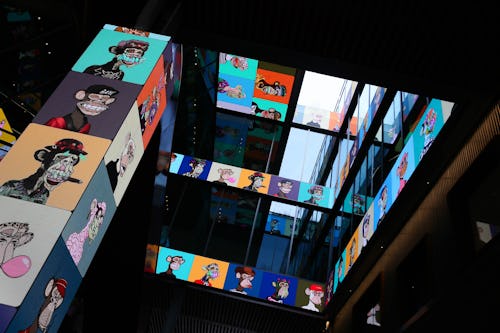

Beyond commerce, there is fun to be had in the form of IRL events. Last fall, in conjunction with the NFT.NYC conference, BAYC organized its first ApeFest, which culminated in a Brooklyn warehouse party with performances by the Strokes, Beck, and Lil Baby — an early celebrity Ape holder.
Back then, the founders could enjoy the festivities without being recognized by the wider BAYC community. “I remember being at ApeFest last year and savoring the fact that I can hang out with anybody, and no one knows who I am,” Ali says. “Once the doxxing happened, I knew that was not going to be the same.” The second ApeFest, during the June return of NFT.NYC, boasted four nights of performances by acts such as LCD Soundsystem, HAIM, Snoop Dogg, Eminem, and (again) Lil Baby.
And then there are the more modest BAYC meetups happening all over the world. For instance, the one I tag along with Solano and Aronow to after our interview. It’s held on the leafy terrace of an otherwise dark basement bar in downtown Manhattan, where some 15 Ape holders — one of whom has launched his own Bored Ape–branded hot sauce — have gathered for drinks. Like the NFT scene in general, the crew skews young and male.
Plans for ApeFest 2023 come up. “I would love to go to Vegas,” someone says. “I don’t know how many Apes are living in Vegas, but…” Someone else throws out the idea of taking the festival out into the desert. “Apechella!” replies Josh Ong, a prominent community member. The concept of ApeFest Tokyo 2025 is broached. Solano suggests going to “a mountain” somewhere.

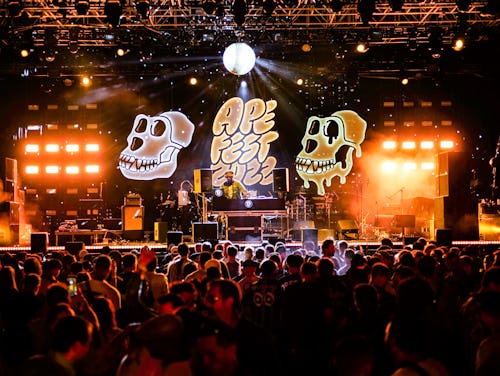
After a quick group photo, the founders’ publicist whisks them back to their hotel. But some holders stick around, so I ask them what it was like meeting the men who created the Apes. “It’s almost surreal because they’re just, like, normal people,” says a young guy who goes by Doris Burke on Twitter (“NOT the ESPN broadcaster,” his bio reads).
“You view them online as this larger-than-life persona,” he continues. “Then you meet them in person, and it’s like, OK, that literally could have been me.”
‘Vicious troll’
Not everyone sees the BAYC founders as “normal people.” Vocal critics on Twitter — and there are many — see them as opportunists at the top of a monkey JPEG pyramid scheme, a charge Input has looked into previously. (The founders naturally take issue with that characterization.) And of course, there is perhaps the most vocal critic of them all: Ryder Ripps.
Ripps early this year set up a website, GordonGoner.com, on which he compares the Yuga Labs logo to the Totenkopf symbol used by Nazis and alleges that the word Yuga is a nod to an alt-right reference. (The company has said the name comes from a villain character in the Nintendo 3DS game The Legend of Zelda: A Link Between Worlds.)
Ripps sees sinister meanings in all the founders’ pseudonyms: Gordon Goner is an anagram for drongo negro. The Smurfs’ Gargamel is an antisemitic depiction of a Jewish person. Sass is a combination of “two primary Nazi military divisions,” SA and SS. Emperor Tomato Ketchup, Ripps points out, was originally the title of a Japanese film widely censored because it’s considered child pornography.
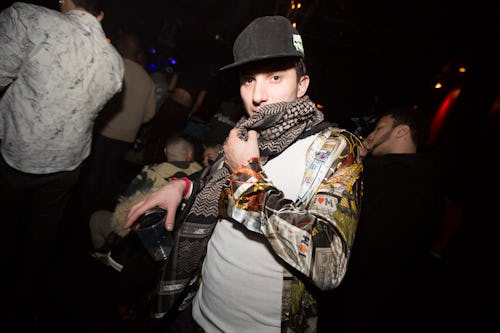
Plus, Ripps claims, the Apes themselves are racist — an example of “simianization,” wherein people compare a certain racial or ethnic group to monkeys to disparage them. He also points to a number of allegedly problematic Ape traits, including “Prussian helmets” (another Nazi dog whistle, per Ripps) and “sushi chef headbands.”
Others have picked up on his cause and taken it even further, like popular YouTuber Philion, who recently posted an hourlong video, titled “BORED APE NAZI CLUB,” dissecting Yuga’s imagery. It has been viewed more than 1.6 million times to date.
Input investigated Ripps’ claims earlier this year, speaking to the artist himself and consulting experts from the Jewish organization the Anti-Defamation League, who expressed doubt about the bulk of the allegations. The ADL experts did, however, agree with Ripps that the “hip-hop” trait (gold chain, gold teeth) and the “sushi chef headband” are both problematic. Still, one of the researchers told Input at the time, “It’s difficult to extrapolate from that that the people behind them are white supremacists.”
Aronow compares the controversy to the rumors surrounding his father’s life and death: “We both are enveloped in a world of conspiracy bullshit.” Both he and Solano turn solemn and use measured words when they talk about Ripps. The accusations are an understandably sensitive subject. (At their photo shoot the next day, Aronow notices what looks like a German insignia on the sleeve of the green army jacket he’s been given to wear. “It’s not my jacket,” he keeps repeating, and the photo team promises to edit the detail out.)
The founders say Ripps is a “vicious troll” who’s good at “cherry-picking” examples to make them look bad in front of those who don’t know better. They bring up the party line, which is that Aronow and Oseary are Jewish, and the other three Yuga founders are children of immigrants.
“Early on, I really was offended,” Oseary says. “I even reached out to [Ripps]. I thought by me talking to him, he would know that I would never be affiliated with anything like that. You know, I’m Israeli, I’m Jewish.”
“This was always supposed to be a fun, irreverent club. It was never supposed to be beyond any kind of criticism.”
The founders add that Ripps has purposefully been trying to get them to sue him. (“Not true by any stretch of anyone’s imagination,” Ripps says in an email.) In June, Yuga Labs filed suit against Ripps in the U.S. District Court for the Central District of California, alleging that Ripps is “scamming consumers into purchasing RR/BAYC NFTs by misusing Yuga Labs’ trademarks” and devaluing “the Bored Ape NFTs by flooding the NFT market with his own copycat NFT collection using the original Bored Ape Yacht Club images.”
“Suggesting that I do things for money is an easy way to deflect attention from [my] criticism’s validity,” says Ripps, who has called his collection a “protest and parody of BAYC.” In a video interview with The Defiant, Ripps called RR/BAYC, “probably the greatest work I’ve done.” He added, “It proves what an NFT is. It’s provoking a company. It’s shedding light on a very important issue. It’s creating an army of educators.”
While discussing the controversy with Solano and Aronow at the hotel, I bring up traits like the sushi chef headband. “This was always supposed to be a fun, irreverent club,” Solano says. “It was never supposed to be beyond any kind of criticism.”
“It’s hard not to offend everybody in the world,” Aronow adds.
Into the metaverse
Three days after meeting Solano and Aronow, I am standing in an all-white room, surrounded by a swarm of other androids who appear to be made of stone. All 4,500 or so of us (including the four founders) gather round as Curtis, a giant Ape wearing a Hawaiian shirt and captain’s hat, explains the trip we’re about to take together. He is accompanied by a squat alien creature called a Koda. This one’s name is Blue.
“Welcome, Voyagers, to the Otherside,” announces Curtis (voiced by an actor) at the onset of the first public demo of Yuga Labs’ new metaverse. “Or rather to the infinity space, kind of like the lobby of the Otherside.”
After some instruction on how to make our avatars dance and the like, a hole opens below us. We all get sucked into a swirling, rainbow passage that spits us out onto a verdant island. “Whoa, it’s raining nerds!” Curtis quips.
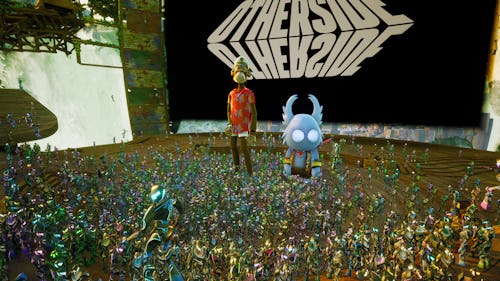
For the next hour or so, we nerds fulfill a series of tasks at Curtis and Blue’s direction. We hunt for a “new pair of glasses” for someone who broke theirs during the recent NFT.NYC conference, and band together to incapacitate a dangerous, drunk Koda (the Otherside’s “first boss fight,” we’re told). At the end of the demo, everybody poses for a group “selfie.”
On NFT Twitter, the response to the demo is rapturous. A few days later, Solano, Aronow, and I catch up on Zoom to talk about how it went. “Honestly, it was one of our best launches,” says Aronow. They point out that while there are quests to complete and drunk bad guys to topple in Otherside, the point of the game isn’t that it’s a game. It’s a virtual chill spot where players can simply hang out with their Ape bros, buying in-world assets with ApeCoin and owning them as NFTs.
It’s an “interoperable metaverse,” the guys explain, because people can take their NFTs in and out of Otherside and use them elsewhere on Web3. Web2 gaming companies don’t allow that, and as result, they make quite a profit, Aronow points out. (Fortnite, for instance, brings in money from players’ purchases of in-game assets, like skins for their avatars; its publisher, Epic Games, made more than $9 billion from the game in 2018 and 2019.) “All that value is going in,” Aronow says. “None of it’s coming back out.”
It’s also a collaborative metaverse. Voyagers — users who buy in with Otherdeed tokens — get a plot of land in the metaverse, with which they can do as they please (“within community informed guidelines,” according to the Otherside litepaper). The Voyagers also get to provide feedback, via a Discord server, that could well influence the shape of Otherside. “They’re along for the ride every step of the way, inputting iteratively on what this is going to become,” Aronow explains.
“The ambition and scale of what we’re trying to accomplish here is massive.”
This, he continues, will help Yuga compete with internet monolith Meta in the race toward the ultimate metaverse. “The ambition and scale of what we’re trying to accomplish here is massive,” he says.
Solano and Aronow believe that they’re the right guys for the job. “In the hands of the wrong person — bad actors, potentially — the metaverse might be a dystopian and scary place,” Aronow says. They envision their metaverse being lush and green and beautiful and full of really weird characters. (Though probably, as someone put it in the Otherside demo’s group chat, packed with “a lot of dudes.”)
Otherside is going to take years to develop, they say. But by the time it’s ready, one has to wonder, who’s going to care? The crypto world moves fast — won’t the Apes fad have passed by then? Plus, the crypto and NFT markets have been tanking as of late.
“It's a loser’s game to try and focus on that aspect,” Solano tells me when I bring up the ongoing crypto winter at the hotel. Plus, they’re not worried. They’ve got money.
“We’re extraordinarily profitable,” Aronow adds. “We have a really sizable war chest here to ensure that we can survive — and not just survive, but build throughout any multi-year bear market. Just keep building and building and building.”
It’s a huge challenge, one that the founders could never have imagined back when they were just a pair of completely anonymous guys discussing dick drawings on a hypothetical bathroom wall. “We might be the biggest thing in NFTs currently, but we’re nowhere near the biggest thing in terms of building metaverses,” Aronow says. “We have some giants to slay.”
Top Image Credits: On Aronow: J.Lindeberg jacket, talent’s own T-shirt; on Solano: Rag & Bone T-shirt
Author: Jessica Klein
Photographer: Martin Schoeller
Stylist: EJ Briones
Grooming: William Murphy
Production: Kiara Brown
Video: Konstantin Yelisevich







